“Start with natural darkness and only add light for specific purposes.” – Australian Government Light Pollution Guidelines (2020)
Figure 1 shows the Milky Way galaxy and the location of our own solar system within that galaxy along the Orion Arm.
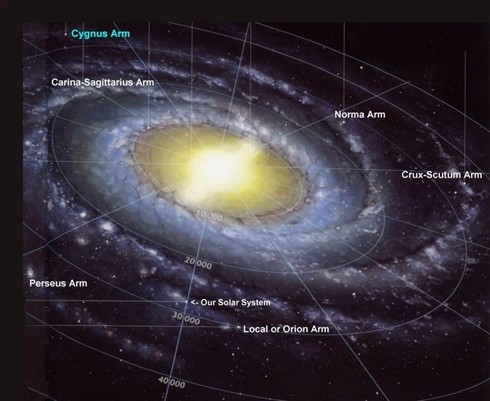
Figure 1 – Milky Way Galaxy[f]
Figure 2 shows the Milky Way as photographed from earth. The thick cluster of stars is the view of the Milky Way galaxy looking edge-on (the arc is due to the wide-angle lens). This is how the nighttime sky looked 150 years ago from almost everywhere on earth.
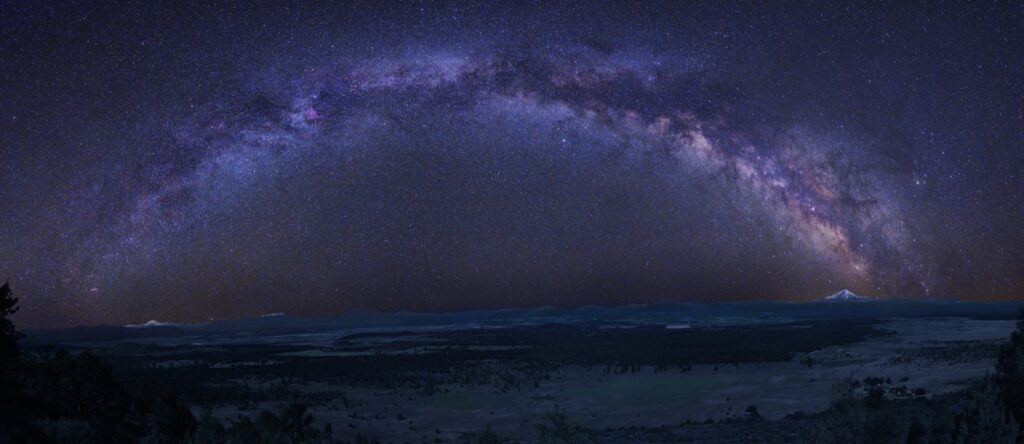
Figure 2 – Milky Way from Earth[f]
Today, almost all of us live under light polluted skies and many of us do not realize that the Milky Way even exists. Figure 3 shows a view of Los Angeles from the Mount Wilson observatory in 1908 on the left and in 2008 on the right. The yellow haze is called Sky Glow. This artificial sky glow is waste light that is escaping into the atmosphere. It provides no environmental or societal benefit, but it wastes energy, decreases the navigation abilities of birds, makes flying and landing a plane more difficult, increases cancer risk in humans and blocks our fundamental right to view the stars, especially the Milky Way.
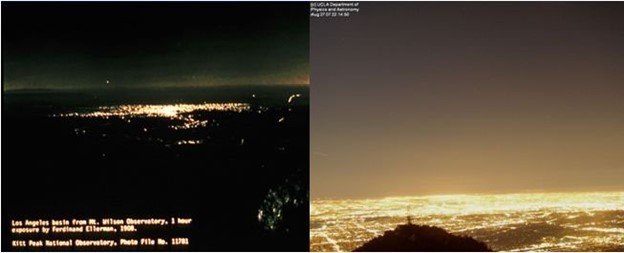
Figure 3 – Los Angeles in 1908 and 2007[f]
Light pollution has been increasing at an unsustainable rate of over 2% per year. Figure 4 shows the dramatic increase of light pollution since the late 1950’s. This light pollution is having a severe impact on the overall functioning of our entire ecosystem.
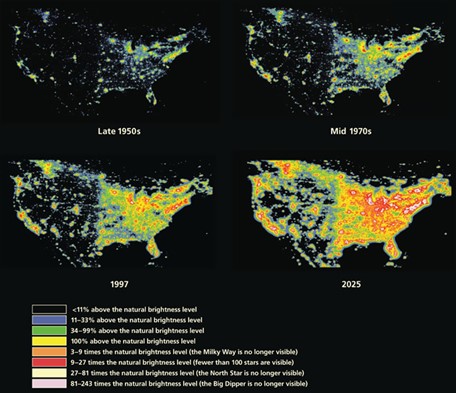
Figure 4 – Light Pollution in the USA[f]
Figure 5 shows a light polluted city. The light pollution increases smog, wastes energy and increases carbon dioxide emissions, and negatively impacts human and ecosystem health.
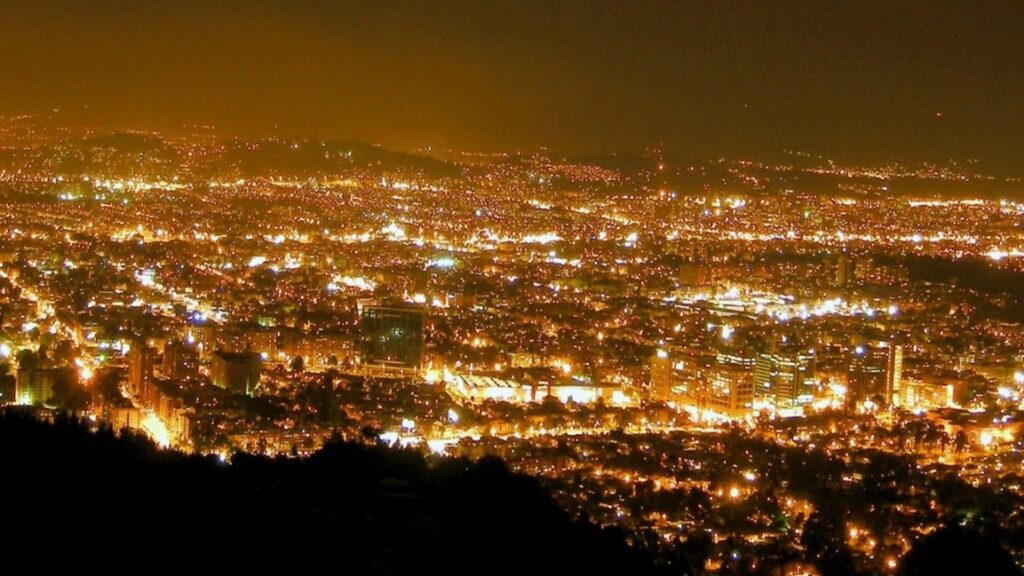
Figure 5 – Light Polluted City[f]
Figure 6 shows Los Angeles from a helicopter on July 4, 2020. The video is here: https://www.facebook.com/ktla5/videos/3987003001372170/
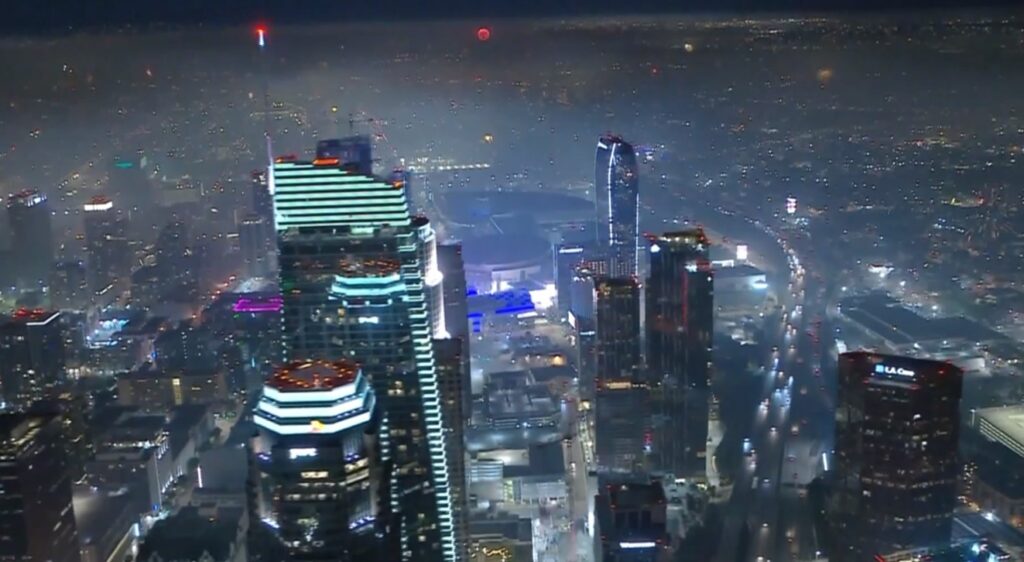
Figure 6 – Los Angeles on July 4, 2020[f]
The helicopter video is valuable from a science and policy view because it shows many light pollution issues at once. From this snapshot, we can see several things.
- The stream of vehicles in the lower right show vehicles with halogen lights (yellow) and LED or HID lights (blue).
- The tall buildings are lit with vanity lighting.
- The red lights on top of the buildings that are used for safety for flying machines are static only. They are not blinking or strobing.
- The lights around the helicopter landing pads on the top of the buildings are not blinking or strobing.
- The hot white light in the center of the photo is high color temperature.
- The fireworks have added both light pollution and air pollution to the valley.
Figure 7 shows an example of wall pack lighting. The rays from these luminaires are shining across property boundaries, into people’s eyes off the property and up into the sky. Property owners do not have the right to violate the civil liberties of others not on their property or steal our view of the Milky Way. These light rays are not serving a useful purpose and are wasted energy.
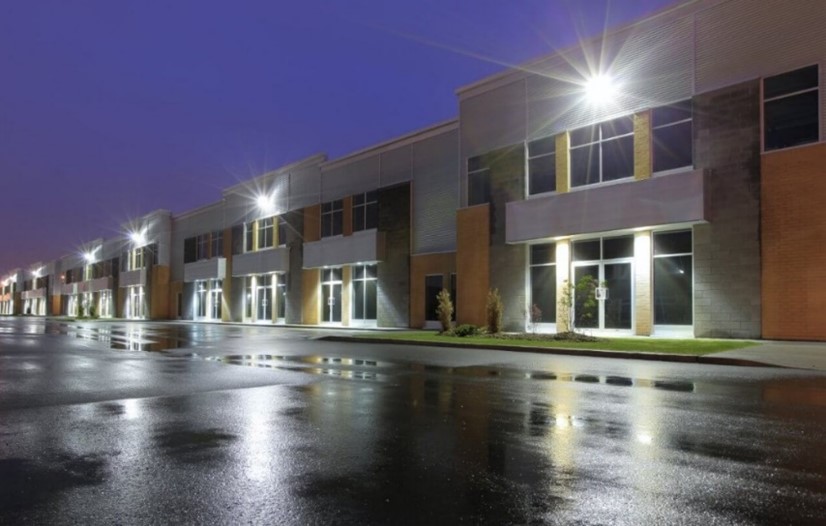
Figure 7 – Light trespass from building lights.[f]
Figure 8 shows an example of an inadequately shielded streetlight. The rays from this light are harming trees and trespassing onto private property instead of just illuminating the pedestrian walkway. Energy is being wasted by providing no useful service.
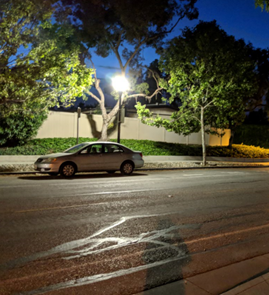
Figure 8 – Light trespass from streetlight
Unless we act, the light pollution situation will only get worse. Haitz’s Law claims that every decade, the cost per lumen (unit of useful light emitted) falls by a factor of 10, and the amount of light generated per LED package increases by a factor of 20, for a given wavelength (color) of light. In a practical sense, this means that the world will continue getting brighter and that it will cost less and less for this to happen.
Measuring Light Pollution
The Bortle scale of light pollution gives a sense of how much light pollution is in an area. We should be able to achieve Class 3 or better everywhere. Sky Brightness is measured in magnitude per square arc-second and should be at least 20.5 mpsas.
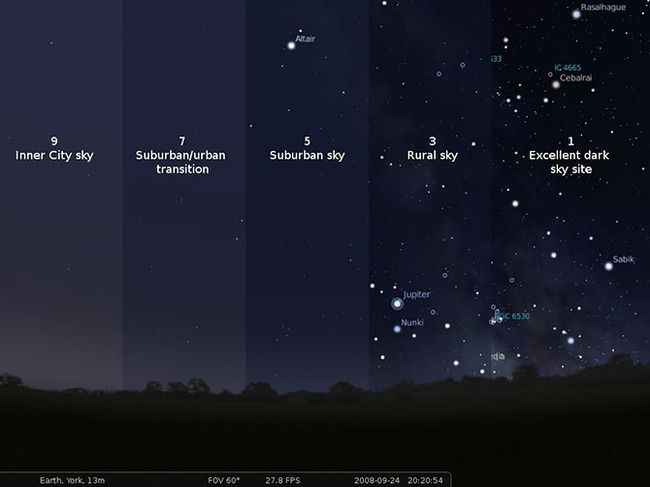
The premise that the purpose of night lighting should be to improve visibility for humans as if it were day is wrong. This premise inevitably takes one out of darkness and scotopic vision which humans have for night time vision. In effect, modern lighting standards destroy darkness. Today’s high power LED streetlights do not give sensitive receptors a chance to recover between the lights, nor do they protect nocturnal animals. LED streetlights also reduce the ambient brightness preventing owls from seeing their prey and the stars become invisible. When we start talking about using photopic vision as the standard for night lighting, we are basically throwing away any semblance of nighttime environment. There are four major areas for lighting standards as I see it that we should be harping away on and captured by regulation:
1. Source – should be soft and not too bright, not directed radiation nor offensive to the eye.
2. Illuminated areas – Illuminated areas should not look glary or white and should be separated by areas of darkness between lamps. Shielding the light to direct glare in only one area is not the answer.
3. Ambient illumination – Overall, a street should look more like night than day. Street lights are not intended to do the job of car headlights. In reality, since the research consistently shows that artificial light at night is toxic, streetlights should be removed and pedestrians can use an incandescent flash light.
4. Ambient light – Should be mostly dark and not use cause humans to use their photopic vision.
5. Fully shielded means outdoor light fixtures shielded or constructed so that no light rays are emitted by the installed fixture at angles above 15 degrees below the horizontal plane and also constructed so that the filament or light source is not visible to the naked eye when viewed from a point higher than 15 degrees below the horizontal plane.
Regulations are needed to prescribe prescriptive and performance standards in all four of the above. LED lights would fail most or all of the categories. The LED cartel must not be setting lighting standards for the public.

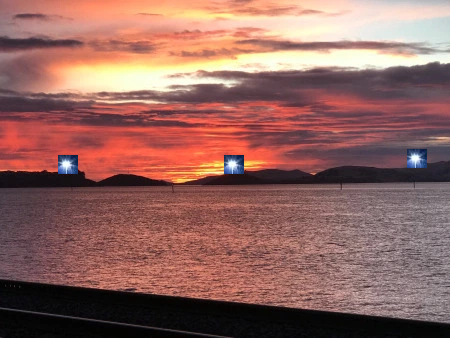
1.1.1. Issues
Sensitive Receptors
In relation to light, sensitive receptors include highly sensitive persons (HSP), those with photophobia, autism, PTSD, epilepsy, bipolar disorder, migraine sufferers and others. The sensitive receptor may react more strongly to light than a neurotypical.
For example, studies have shown that artificial light at night interrupts sleep and additional studies have shown that children with autism whose sleep is degraded have a higher chance of developing more serious emotional issues as the years go by. As another example, for a migraine sufferer even a small amount of light may increase the pain of the headache.
Sensory Processing Sensitivity (SPS) is found in roughly 20% of humans and over 100 other species. This trait is associated with greater sensitivity and responsiveness to the environment and to social stimuli.[f] SPS is becoming increasingly associated with identifiable genes, behavior, physiological reactions, and patterns of brain activation. People with SPS include Highly Sensitive Persons, people with photophobia, autism, migraine sufferers and others. High color temperature light can trigger negative emotions or cause distraction for those with SPS.
A migraine headache is uniquely exacerbated by light. In studies, researchers determined that green light exacerbates a migraine headache less than blue light. These findings suggest that patients’ experience with color and migraine photophobia could originate in cone-driven retinal pathways, fine-tuned in relay thalamic neurons outside the main visual pathway, and preserved by the cortex.[f] This means that high color temperature LED lights with large spikes of blue wavelength light will be more likely to exacerbate or cause migraine headaches.
It is well known that humans need high quality sleep to be healthy. A continual pattern of short sleep durations can lead to premature death. Lesser known is the fact that short sleep duration is strongly associated with severe social impairment and a failure to develop peer relationships in children with autism.[f] Since it has also been shown that artificial light at night affects sleep duration, once consequence of ALAN is a negative impact on the social growth of children with autism.
Circadian Rhythms
The circadian rhythms are the daily cycles that biological systems go through. There are specific times of the 24-hour cycle for sleeping, eating, being active, and resting. Biological clocks consist of specific molecules that control other molecules for proper functioning. In humans, these biological clocks are controlled by a master clock in the brain. The main cues for the brain’s master clock are dark and light.
Light pollution is negatively affecting our circadian rhythms and it is now more difficult for biological clocks to synchronize. This disruption in circadian rhythms affects processes at the cell level and increases risk of cancers, metabolic dysfunction, and mood disorders. Light can even penetrate the human skull and affect brain functions and disease.
The circadian clock affects physiologic processes in almost all organisms. These processes include brain wave patterns, hormone production, cell regulation, and other biologic activities. Disruption of the circadian clock is linked to several medical disorders in humans, including depression, insomnia, cardiovascular disease, and cancer.
The 24-hour day/night cycle, known as the circadian clock, affects physiologic processes in almost all organisms.[f] Irregular rhythms have been linked to various chronic health conditions, such as sleep disorders, obesity, diabetes, depression, bipolar disorder, and seasonal affective disorder.[f] Circadian disruption by nighttime light perturbs those processes and is associated with increasing incidence of certain cancers, metabolic dysfunction and mood disorders.[f] The subtle effect of extraocular light is likely critical for healthy human brain functions and disease.[f]
Impacts on Sleep
Sleep is a necessary component of human function. The hormone melatonin controls our energy levels and during the day, melatonin is suppressed by the blue wavelength light in the sun. As the sun sets, and the blue wavelengths are reduced, melatonin production increases and we feel drowsy and ready to sleep. During sleep, our cells repair themselves from the damage that occurred during the day.
Artificial Light at Night (ALAN), especially high color temperature light with large amounts of blue wavelength light, interrupt our sleep. With exposure to blue wavelength light, our melatonin levels remain suppressed and our cells do not get the repairs they need. Because the cells remain damaged, this leads to increases in diseases such as breast and prostate cancers. The lack of quality sleep also leads to mood disorders.
Exposure to light at night strongly suppresses melatonin, which interferes with sleep timing and sleep quality.[f] Light at night negatively affects mood[f] Light at Night levels were associated with higher incidence of breast cancer.[f] ”Just like sunset, the light source (1900 Kelvin) is an “artificial light of harmony” which promote the secretion of melatonin, resulting in an improved sleeping quality.[f]
Impacts on Wildlife
Bird and insect populations are in steep decline. One of the major contributors to this decline is light pollution. Figure 9 shows insects clustering around the high blue content LED lights, while essentially ignoring the amber colored light. The insects will eventually die of exhaustion. Hundreds of millions of birds die each year crashing into buildings, with light pollution being the cause of the initial attraction.
Mammals are also deeply affected by anthropogenic light pollution. Rodents, for example, depend on the cover of darkness to roam and forage for food. Light pollution either forces them to stay closer to home or exposes them to more predation. For threatened and endangered species, light pollution could mean the end of existence of the entire species.
Figure 9 – Insects Attracted to Blue Wavelength Light
Studies showed that changes in light levels affected foraging, movement, activity patterns, vigilance, mating and reproduction, community and population metrics, predation and mortality, physiology and development, and vocal behavior.[f] This finding implies broad‐scale attraction to artificial light while airborne, impeding selection for extensive forest habitat.[f] Given that most songbirds migrate at night, it’s no surprise that light pollution is a significant contributor to the harm of these birds.[f] Artificial Light at Night reduces habitat suitability.[f]
Energy Waste
The energy being used to operate the lights is wasted energy if the light is escaping into the sky or trespassing into unwanted areas. Globally, energy for artificial lighting produces over 2 billion metric tons of CO2 emissions annually, which is about 20% of global emissions. Considering that much of this lighting is waste light, eliminating this waste would reduce harm from the light itself and reduce the amount of damage caused by excess CO2 in the atmosphere.
LED lights were promoted as an energy saving measure that could reduce CO2. However, most outdoor LED light installations use high color temperature LED lights with a large spike of blue wavelength light. This higher energy light increases light pollution. In addition, manufacturers and retailers have found that they can sell LED lights for uses and locations that previously did not exist which is most likely leading to increased energy use rather than decreasing it as had been originally hoped. Adding light into our already polluted nighttime environment is a waste of energy.
The federally funded National Optical Astronomy Observatory (NOAO) reports that poorly-aimed, unshielded outdoor lights waste $2 billion (17 billion kilowatt-hours) of energy in the U.S. each year.[f] Technological innovations and changes in lighting strategies should consider benefits for reductions in greenhouse gases and energy consumption in parallel with their potential ecological impacts.[f]
Air Pollution
Research has shown that light pollution increases air pollution. This happens because the air pollution we put into the atmosphere during the day is partially broken down by chemical processes at night. The ALAN impairs this chemical process, reducing the amount of air pollution that can be cleansed at night.
Bright city lights make air pollution worse because the glare of the lights interferes with chemical reactions that clean the air of pollution during the night.[f]
1.1.2. Proposed Regulations
To increase healthy darkness, reduce light pollution and decrease energy use, we can set measurable light pollution limits for geographic areas. Satellite data and mapping techniques now allow us to measure light pollution accurately.
In Figure 10, the black dot represents Sacramento, California. All areas of color other than black represent light pollution. This represents energy that was used to power the light, but then the light itself was sent into outer space to the benefit of no one.
Sky Brightness is measured in magnitude per square arc-second (mpsas). The ocean measures about 22 mpsas (black color), while Sacramento measures about 10 mpsas (white color).
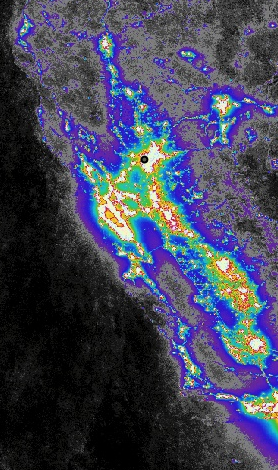
Figure 10 – Satellite view of light pollution
We propose that a system that incentivizes each city and county to achieve higher levels of Sky Brightness. The State shall pay a dividend to each county and city that achieves 18 mpsas or better on a sliding scale. The better the mpsas score, the more money the State will pay. On the other hand, cities and counties that fall below 18 mpsas will be required to pay a fee to the State. The lower the mpsas score, the larger the fee.
The 18 mpsas value should change over time. While 18 mpsas can be used for the year 2020 through 2025, this value should increase by 1 every 5 years until the mpas value reaches 22. At that point, any city that causes light pollution shall need to pay a fee to the State.
The mpsas value would also be determined by time of day. The 18 mpsas value would be used until 11pm. However, a value of 20 mpsas should be used for late night hours of 11pm to 5am when there is almost no need for ALAN.
This mechanism is fair because the environmental and health costs of light pollution are enormous and the energy used to power this wasted light contributes to climate change. Therefore, cities and counties that increase darkness will be rewarded and cities and counties that continue to pollute will be required to pay to cover the expenses of light pollution. Cities and counties are free to develop their own specific plans for how to increase darkness and achieve a higher Sky Brightness score. One way that cities can reduce light pollution is by establishing regulations to control backlight, uplight, glare and light trespass and an enforcement mechanism to limit the fee that the city or county would need to pay to the State.
The State of California will need to pay for satellite data and a computer system to process the data and to handle the fees and rebates to cities. However, the costs to operate the system will be offset by the fees paid by cities and counties. In turn, the cities and counties will be motivated to reduce the costs associated with public health and environmental damage due to light pollution. The overall cost, then, will be a net savings.
For example, Figure 11 shows examples of replacement lights for standard wall packs. The angled version reflects amber light off the wall, eliminating backlight and uplight and greatly reducing light pollution, glare, and light trespass. Cities would be advised to require this type of wall pack and prohibit standard wall packs that cause light pollution.
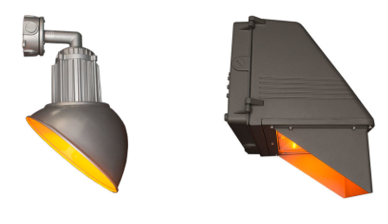
Figure 11 – Outdoor Lights with Low Light Pollution